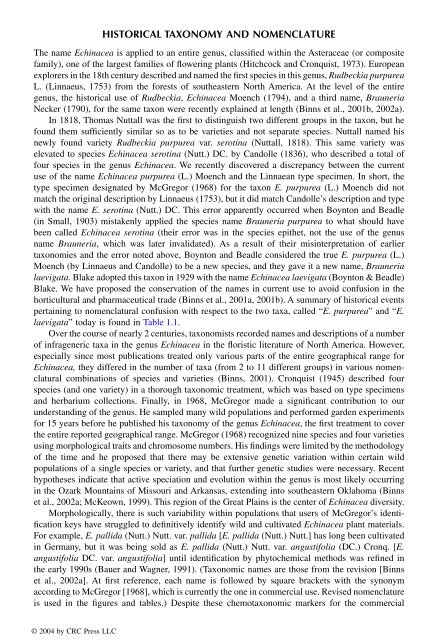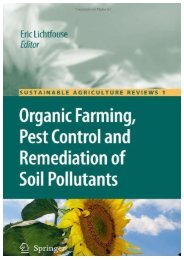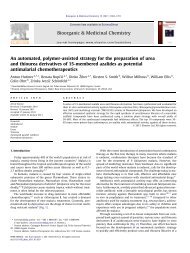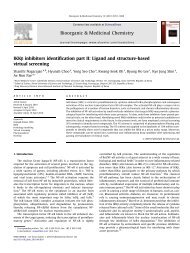Echinacea: The genus Echinacea
Echinacea: The genus Echinacea
Echinacea: The genus Echinacea
You also want an ePaper? Increase the reach of your titles
YUMPU automatically turns print PDFs into web optimized ePapers that Google loves.
4 <strong>Echinacea</strong>: <strong>The</strong> <strong>genus</strong> <strong>Echinacea</strong><br />
HISTORICAL TAXONOMY AND NOMENCLATURE<br />
<strong>The</strong> name <strong>Echinacea</strong> is applied to an entire <strong>genus</strong>, classified within the Asteraceae (or composite<br />
family), one of the largest families of flowering plants (Hitchcock and Cronquist, 1973). European<br />
explorers in the 18th century described and named the first species in this <strong>genus</strong>, Rudbeckia purpurea<br />
L. (Linnaeus, 1753) from the forests of southeastern North America. At the level of the entire<br />
<strong>genus</strong>, the historical use of Rudbeckia, <strong>Echinacea</strong> Moench (1794), and a third name, Brauneria<br />
Necker (1790), for the same taxon were recently explained at length (Binns et al., 2001b, 2002a).<br />
In 1818, Thomas Nuttall was the first to distinguish two different groups in the taxon, but he<br />
found them sufficiently similar so as to be varieties and not separate species. Nuttall named his<br />
newly found variety Rudbeckia purpurea var. serotina (Nuttall, 1818). This same variety was<br />
elevated to species <strong>Echinacea</strong> serotina (Nutt.) DC. by Candolle (1836), who described a total of<br />
four species in the <strong>genus</strong> <strong>Echinacea</strong>. We recently discovered a discrepancy between the current<br />
use of the name <strong>Echinacea</strong> purpurea (L.) Moench and the Linnaean type specimen. In short, the<br />
type specimen designated by McGregor (1968) for the taxon E. purpurea (L.) Moench did not<br />
match the original description by Linnaeus (1753), but it did match Candolle’s description and type<br />
with the name E. serotina (Nutt.) DC. This error apparently occurred when Boynton and Beadle<br />
(in Small, 1903) mistakenly applied the species name Brauneria purpurea to what should have<br />
been called <strong>Echinacea</strong> serotina (their error was in the species epithet, not the use of the <strong>genus</strong><br />
name Brauneria, which was later invalidated). As a result of their misinterpretation of earlier<br />
taxonomies and the error noted above, Boynton and Beadle considered the true E. purpurea (L.)<br />
Moench (by Linnaeus and Candolle) to be a new species, and they gave it a new name, Brauneria<br />
laevigata. Blake adopted this taxon in 1929 with the name <strong>Echinacea</strong> laevigata (Boynton & Beadle)<br />
Blake. We have proposed the conservation of the names in current use to avoid confusion in the<br />
horticultural and pharmaceutical trade (Binns et al., 2001a, 2001b). A summary of historical events<br />
pertaining to nomenclatural confusion with respect to the two taxa, called “E. purpurea” and “E.<br />
laevigata” today is found in Table 1.1.<br />
Over the course of nearly 2 centuries, taxonomists recorded names and descriptions of a number<br />
of infrageneric taxa in the <strong>genus</strong> <strong>Echinacea</strong> in the floristic literature of North America. However,<br />
especially since most publications treated only various parts of the entire geographical range for<br />
<strong>Echinacea</strong>, they differed in the number of taxa (from 2 to 11 different groups) in various nomenclatural<br />
combinations of species and varieties (Binns, 2001). Cronquist (1945) described four<br />
species (and one variety) in a thorough taxonomic treatment, which was based on type specimens<br />
and herbarium collections. Finally, in 1968, McGregor made a significant contribution to our<br />
understanding of the <strong>genus</strong>. He sampled many wild populations and performed garden experiments<br />
for 15 years before he published his taxonomy of the <strong>genus</strong> <strong>Echinacea</strong>, the first treatment to cover<br />
the entire reported geographical range. McGregor (1968) recognized nine species and four varieties<br />
using morphological traits and chromosome numbers. His findings were limited by the methodology<br />
of the time and he proposed that there may be extensive genetic variation within certain wild<br />
populations of a single species or variety, and that further genetic studies were necessary. Recent<br />
hypotheses indicate that active speciation and evolution within the <strong>genus</strong> is most likely occurring<br />
in the Ozark Mountains of Missouri and Arkansas, extending into southeastern Oklahoma (Binns<br />
et al., 2002a; McKeown, 1999). This region of the Great Plains is the center of <strong>Echinacea</strong> diversity.<br />
Morphologically, there is such variability within populations that users of McGregor’s identification<br />
keys have struggled to definitively identify wild and cultivated <strong>Echinacea</strong> plant materials.<br />
For example, E. pallida (Nutt.) Nutt. var. pallida [E. pallida (Nutt.) Nutt.] has long been cultivated<br />
in Germany, but it was being sold as E. pallida (Nutt.) Nutt. var. angustifolia (DC.) Cronq. [E.<br />
angustifolia DC. var. angustifolia] until identification by phytochemical methods was refined in<br />
the early 1990s (Bauer and Wagner, 1991). (Taxonomic names are those from the revision [Binns<br />
et al., 2002a]. At first reference, each name is followed by square brackets with the synonym<br />
according to McGregor [1968], which is currently the one in commercial use. Revised nomenclature<br />
is used in the figures and tables.) Despite these chemotaxonomic markers for the commercial<br />
© 2004 by CRC Press LLC









